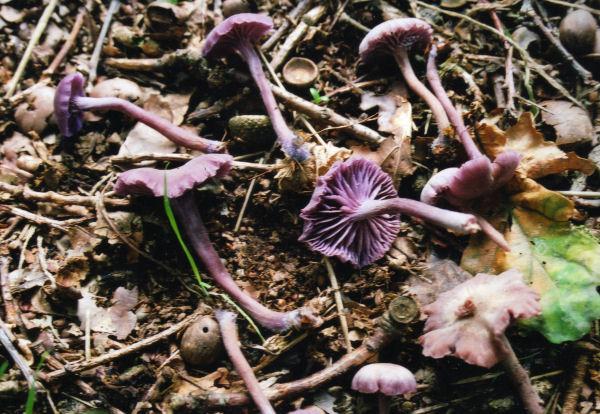Chicken of the Woods (Laetiporus sulfureus)

There are a few things to be aware of when picking this mushroom. Firstly, there's some evidence that if it's growing on either yew or eucalyptus, it might be poisonous. Secondly, you really only want it when it's young and juicy; it gets old and woody later, and it isn't good eating any more. Thirdly, there are some extremely rare examples of children hallucinating after eating this mushroom. So don't feed it to any tiny tots.
Other than that, munch away. It's remarkable just how much this mushroom really does taste like chicken, so I recommend making the most of that by adding it to chicken stews and curries. I like to keep some in the freezer, ready to be diced up and marinated in olive oil and herbs, making an ideal barbecue treat for vegetarians." | |
Fairy Ring Mushroom (Marasmius oreades)
"Be careful with this one. Really careful. You could mistake one of the toxic Clitocybe species or it, and that wouldn’t be good. Could be fatal. But once you get the eye for this mushroom, it’s a cracker, it really is.
A lot of people write books on wild foods that you can find in immaculate woodlands that you never ever get to. They tell you about chanterelles, ceps, morels and the like. What they don’t tell you about is this little mushroom that forms most of the fairy rings in parks, football pitches, school playing fields, etc. And it has an almondy, mushroomy flavour as good as any other mushroom.
It’s not big, so you want to pick plenty for a meal. This isn’t a problem; you might find rings that are ten yards across or more, with hundreds of mushrooms on them. You get them from Spring through till Autumn, but in May they’re at their best because there is less chance of them being full of maggots. As you pick them, pull the stipe (stem) out and look at where it joins the cap; you want there to be no maggot holes there.
And best of all, they dry very well. Thread the caps onto cotton and hang them somewhere warm to dry."[/img]
| |
|
Giant Puffball (Langermannia gigantea)
The giant puffball is a mammoth amongst mushrooms. It is a near spherical fungal fruiting body, somewhere between a few inches and a yard or more in diameter. It is attached to the ground by a thin stem, which breaks upon ripening allowing the puffball to dry out and release spores (sometimes for a year or two) as it rolls about in the wind.
If you are lucky enough to find a young, fresh specimen (it MUST be white all the way through; as it yellows, eventually turning green and brown, it will make you sick) then you are in for a real treat. Take it home (laughing maniacally as you do so), slice it into half inch steaks, and fry it (battered or covered in egg and breadcrumbs if you like). It’s kind of like a strongly mushroom flavoured marshmallow. Or dice it for stews and soups, slice it up and add some olive oil, put in a pot and bake it... Even stuff it with mince and its own chopped innards before baking (the smell it gives out when you cook it that way is almost overpowering!). Whatever you do with it, it is a fine tasting mushroom.
Different guidebooks will give different habitats for the giant puffball, but I personally think that it grows where it likes. I’ve found them on muddy lake banks that are covered in water for two months of most years, I’ve picked it from a pile of waste soil next to a rugby pitch, and I’ve found a ring of a dozen football sized puffballs in a patch of scrubby woodland by a railway track. The only linking thing I can find is that the soil must be relatively undisturbed for a few years. I can’t really offer definitive advice on what habitat it prefers, but I will stick my neck out and say that sooner or later, if you keep your eyes open, you’ll find one.
Can’t easily be misidentified, unless you find a football in the woods." | |
|
When the pics aren't from Downsizer, it might be worth mentioning where the pics are from or including a link. Always a polite thing to do
Or ask for pics from Downsizers of course. Here, for example, is a chanterelle from Wakefield:
| |
|
|  |
Deceivers... (Laccaria laccata)

Thats from outside the chemistry department of Cambridge University, right on Lensfield Road... Very pretty but I didn't eat them! October '01.
And the similar purple species, the amethyst deceiver, Laccaria amethysta

Thats from Thetford forest, same roll of film as the other pic so only more or less the same time as the deceivers.
They're both slight little shrooms, only a few of centimeters across and the shape is very variable. But when found in profusion they're really nice and tasty, well worth having. | |
 Posted: Thu Oct 26, 06 10:43 am Post subject: Posted: Thu Oct 26, 06 10:43 am Post subject: |  |
Agrocybe cylindracea


"...cream at first, darker brown with age, with persistent ring which soon becomes dusted brown by the spores. Flesh white in the cap and stem, brown in the stem base. Taste nutty, smell of old wine casks. Habitat in tufts wood especially willows and poplars. Season all year round." | |
1 comment:
Thanks for sharing such informative information.
We are Canada's #1 "online dispensary"" products. Speed Greens is Canada's favorite and most trusted!
We're offering more, Please feel free to check our "edibles section!""
"Dried Mushrooms"
"Mushroom Edibles"
Click here to get some more information about our store.
Post a Comment